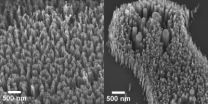(Press-News.org) Carbon nanofibers hold promise for technologies ranging from medical imaging devices to precise scientific measurement tools, but the time and expense associated with uniformly creating nanofibers of the correct size has been an obstacle – until now. A new study from North Carolina State University demonstrates an improved method for creating carbon nanofibers of specific sizes, as well as explaining the science behind the method.
"Carbon nanofibers have a host of potential applications, but their utility is affected by their diameter – and controlling the diameter of nanofibers has historically been costly and time-consuming," says Dr. Anatoli Melechko, an associate professor of materials science and engineering at NC State and co-author of a paper describing the study.
Specifically, the researchers have shown that nickel nanoparticles coated with a ligand shell can be used to grow carbon nanofibers that are uniform in diameter. Ligands are small organic molecules that have functional groups (parts of the molecule) that bond directly to metals. Nickel nanoparticles are of particular interest because – at high temperatures – they can serve as catalysts for growing carbon nanofibers.
"What we learned is that the ligand shell, which is composed of trioctylphosphine, undergoes chemical changes at high temperatures – gradually transforming into a graphite-like shell," says Dr. Joe Tracy, a co-author of the paper and assistant professor of materials science and engineering at NC State. "These 'graphitic' shells prevent the nickel nanoparticles from lumping together at elevated temperatures, which is a problem for high-temperature applications involving nanoparticles."
Using nanoparticles to grow nanofibers is useful, because the fibers tend to have the same diameter as the nanoparticles they are growing from. If you need nanofibers that are 20 nanometers (nm) in diameter, you would simply use nanoparticles that are 20 nm in diameter as your catalyst.
"This is why controlling the diameter of the nanoparticles is important. If they begin to lump together at high temperatures, you end up growing nanofibers of many different, larger sizes," Melechko says. "This research gives us a better fundamental understanding of the relationship between nickel nanoparticles, ligands and carbon nanofiber synthesis."
Using nanoparticles to grow nanofibers has another benefit – it allows you to define where the nanofibers grow and how they are arranged. If you need the nanofibers to grow in a specific pattern, you would arrange the nanoparticles in that pattern before growing the fibers.
INFORMATION:
The paper, "Effects of Ligand Monolayers on Catalytic Nickel Nanoparticles for Synthesizing Vertically Aligned Carbon Nanofibers," was published online March 16 in ACS Applied Materials & Interfaces. The paper was co-authored by Melechko, Tracy; NC State Ph.D. students Mehmet Sarac, Aaron Johnston-Peck and Ryan Pearce; NC State undergraduate Robert Wilson; former NC State post-doctoral research associate Dr. Junwei Wang; and Dr. Kate Klein of the National Institute of Standards and Technology. The research was funded by the National Science Foundation, U.S. Department of Energy, U.S. Department of Education, the Republic of Turkey and Protochips, Inc.
Study finds more efficient means of creating, arranging carbon nanofibers
2011-03-18
ELSE PRESS RELEASES FROM THIS DATE:
Badbeat.com Donates Revenue Percentage to Support UK's Red Nose Day
2011-03-18
Badbeat.com, the original and leading online poker staking business, will be donating 10% of ALL affiliate revenue generated by the Badbeat players on Friday 18th March to Comic Relief in support of Red Nose Day.
The Badbeat management has urged their players to help change lives both in the UK and across Africa, challenging them to raise as much money as possible playing poker day and night!
"Red Nose Day is a day like no other; when the whole country gets together to help change countless lives," said Badbeat Managing Director, John Conroy. "We're incredibly happy ...
Study provides new tool to monitor coral reef 'vital signs'
2011-03-18
MIAMI – March 17, 2010 -- University of Miami (UM) Rosenstiel School of Marine & Atmospheric Science scientist Chris Langdon and colleagues developed a new tool to monitor coral reef vital signs. By accurately measuring their biological pulse, scientists can better assess how climate change and other ecological threats impact coral reef health worldwide.
During a March 2009 experiment at Cayo Enrique Reef in Puerto Rico, the team tested two new methods to monitor biological productivity. They compared a technique that measures changes in dissolved oxygen within ...
Johns Hopkins team creates stem cells from schizophrenia patients
2011-03-18
Using skin cells from adult siblings with schizophrenia and a genetic mutation linked to major mental illnesses, Johns Hopkins researchers have created induced pluripotent stem cells (iPS cells) using a new and improved "clean" technique.
Reporting online February 22 in Molecular Psychiatry, the team confirms the establishment of two new lines of iPS cells with mutations in the gene named Disrupted In Schizophrenia 1, or DISC1. They made the cells using a nonviral "epiosomal vector" that jumpstarts the reprogramming machinery of cells without modifying their original ...
Neuropsychological treatment reduces after-effects in patients with acquired brain injury
2011-03-18
Researchers at the University of Granada have proved that neuropsychological rehabilitation helps in significantly reducing cognitive, emotional and behavioural after-effects in patients with acquired brain injury, generaly due to traumatic brain injury and ictus. These patients should not wait to be treated later by the social services, since early intervention (within six months after the traumatism) reduces further after-effects.
Despite the prevention campaigns launched for reducing traffic accidents and improving heart-friendly habits, traumatic brain injury and ...
In pilot study, screening detects potentially serious heart conditions in healthy children
2011-03-18
A pilot study in healthy children and adolescents shows that it is feasible to screen for undiagnosed heart conditions that increase the risk of sudden cardiac arrest (SCA). Adding a 10-minute electrocardiogram (EKG or ECG) to a history and physical examination identified unsuspected cases of potentially serious heart conditions.
Although more research is needed, the preliminary results suggest that a relatively low-cost screening might help identify children who are at risk for sudden cardiac arrest, possibly preventing childhood death.
"In the United States, the ...
Kids Keeping Up With The Joneses
2011-03-18
Halifax Savings research has shown that children in Wales have the highest ownership levels of games consoles and mobile phones across the nation and also spend the most amount of money on computer games and equipment.
They also do extremely well when it comes to owning an iPod or MP3 player and only fall down slightly on music downloads and mobile phone expenditure.
A full house for Welsh gamers
100% of the children surveyed in Wales owned a games console, well above the national average of 91%.
Children in Wales also spent the highest amount of money on computer ...
Tiny 'on-chip detectors' count individual photons
2011-03-18
Washington, D.C. (March 17, 2011) -- A team of researchers has integrated tiny detectors capable of counting individual photons on computer chips. These detectors, called "single-photon avalanche diodes (SPAD)," act like mini Geiger counters, producing a "tick" each time a photon is detected.
The researchers present their findings in Applied Physics Letters, a journal published by the American Institute of Physics.
"In the past, making these detectors required specialized processes, but recently there has been tremendous progress in making these devices in 'standard' ...
New targeted drug helps smokers stub it out
2011-03-18
Researchers working in a research project within the Academy of Finland's Research Programme on Substance Use and Addictions have been developing a targeted drug that could aid in smoking reduction therapy. The new drug slows down the metabolism of nicotine, which would help smokers to cut down their smoking.
Nicotine is absorbed rapidly through the lining of the mouth but most readily through the lungs, from where it quickly passes through the body and into the brain. Once the nicotine reaches the liver, it is metabolised by an enzyme called CYP2A6. Preliminary studies ...
Green sludge can protect groundwater from radioactive contamination
2011-03-18
Radioactive waste decaying down at the dump needs millions of years to stabilize. The element Neptunium, a waste product from uranium reactors, could pose an especially serious health risk should it ever seep its way into groundwater – even 5 million years after its deposition. Now, researchers at the University of Copenhagen have shown the hazardous waste can be captured and contained. The means? A particular kind of green goop that occurs naturally in oxygen-poor water.
Bo C. Christiansen is a geochemist at the University of Copenhagen who specializes in "green rust". ...
Give Up For Lent and Be Abroad This Time Next Year
2011-03-18
With the cost savings of giving something up for Lent likely to reach GBP57.37 by Easter Sunday, Lloyds TSB Savings believes that people may consider prolonged or permanent periods of abstinence to enable them to meet long-term financial goals.
Of the 66% making a lifestyle change, a third (30%) would like to sell unwanted possessions on eBay, rising to almost half (48%) of 18 to 24 year olds, but decreasing to as few as one in five (19%) in Scotland. One quarter (25%) would like to shop less, 22% to start cycling or walking to work and cutting back on going out for ...



